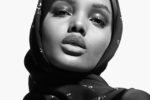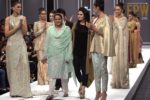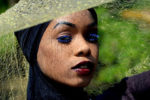Through the years MMW has had the opportunity to analyze Muslim women’s role in fashion in a variety of contexts. Some of our articles have discussed fashion in the context of in Mali, Russia and Chechnya, and a piece by Sharrae featured what is thought to be the only Muslim Model agency: Underwraps.
Underwraps is famous not only for its inclusion of hijab-wearing women, but also for its founder Nailah Lymus, featured in one of my pieces in 2011. Last week, Underwraps Model Agency made it back to the headlines through two articles; one written by Hajer Naili for womensenews.com and another one by Omar Sacirbey for the Huffington Post. While the two articles discuss Underwraps’ endeavour to bring modest clothing to Muslim and non-Muslim women while providing access to Muslim women to the modeling industry, Naili’s piece makes and interesting read as she is, herself, one of the models.
Naili’s piece does not only critique the use of female nudity to get attention (for example, she mentions Femen, which I discussed last year), but it also asserts Underwraps’ point of difference, and its emphasis on catering to modest women (Muslim or not). Yet, coverage of Underwraps in different outlets has constantly played with the “free vs. oppressed” discourse and emphasizes Muslim women’s “tendency” to be more modest and perhaps more “religious” than other women. This suggests that if they are not modest enough they risk facing backlash not only from their communities, but also from those who expect Muslim women to be “pious and modest.”
In this sense, one way of seeing Muslim fashion is as a way to allow Muslim women to bring hijabs and modesty to the runway without the aesthetical restrictions of thin and “almost-naked” models. For Naili, Underwraps brings along a variety of possibilities that enable women to be themselves and feel free in their own skin. Naili explains: “I have never believed that exposing my naked body would make me feel freer.”
When I started looking into Muslim women and fashion a couple of years ago, I celebrated the inclusion of Muslim models in the industry and the initiative of Muslim designers in coming up with different creative ideas for Muslim women. However, I have recently developed a more ambivalent relationship with the fashion industry and Muslim women involved in it.
While I believe that Muslim women should have a place in the fashion industry as designers and models, I feel unsure about what is being said about their “actual” role and the standards being endorsed. After reading Naili’s piece I kept wondering what it all meant for Muslim women like me who are, perhaps, not “as modest” as others… would they tell me to go over to Vogue because I do not comply with the “Islamic” aesthetics that they want to portray? Would I have to accept their standards of modesty in order to join the agency? Is there a place for me as a “less-modest” Muslim? What is the definition of modesty we are using here anyway?
The thoughts of how Islam, modesty and piety come together on the runway became more important for me after reading a piece by Marjorie Jolles and Shira Tarrant with the title “Feminism can Decode Politics of Fashion,” where the authors do a great job in pointing out the personal challenges that fashion can bring as well as the political and philosophical questions that it raises, pointing out that “Fashion creates collective identity, but also restricts individual voice.”
So is Muslim fashion falling into the mainstream? Is “Muslim fashion” creating a collective identity that will continue to keep some of us excluded or alienated? Personally, I remain somewhat conflicted…I fear that what started as a personal celebration for Muslim women’s accomplishments on the runway will turn out to be another restrictive environment that will be no different than others in defining terms like beauty and modesty. Yet, I remain positive. I hope Muslim women in the fashion industry will broaden the industry’s horizons instead of confining them to issues of “modest clothing” for “modest girls.”




